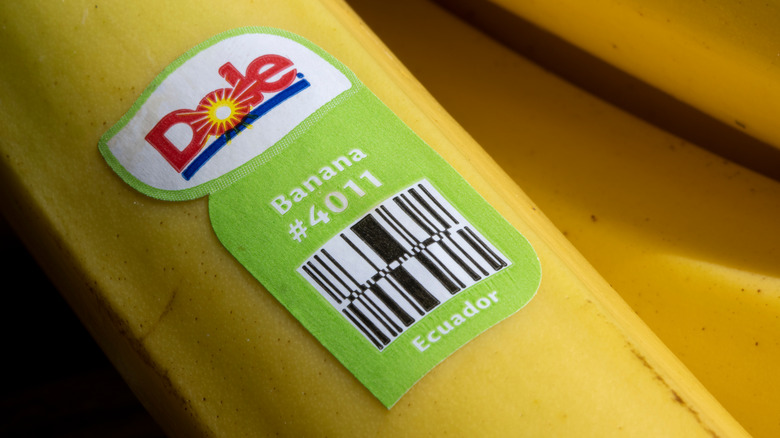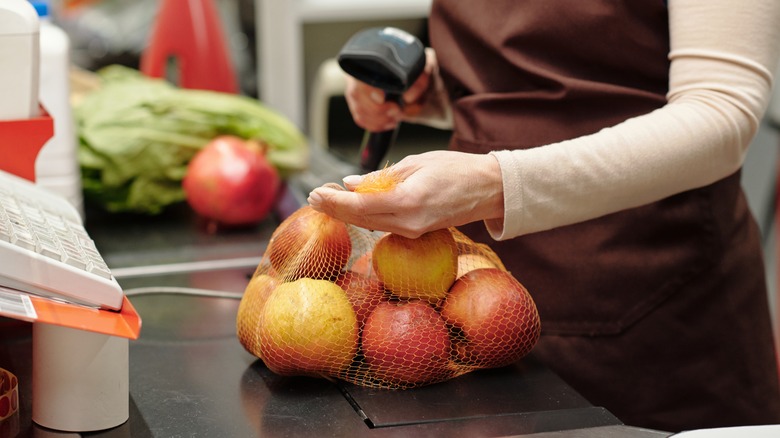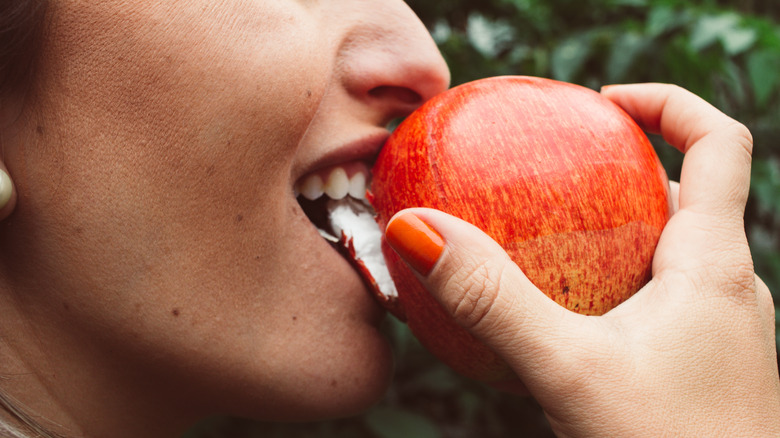What's The Point Of Stickers On Fruit, And Are They Edible?
Browse through the produce department of any grocery store, and you'll see rows of apples, pears, and bananas, all with those little stickers informing you that your apple is Fuji, your pear is D'anjou, and your banana is ... definitely a banana. Aside from letting you know which type of fruit you're getting — information that definitely comes in handy in a section full of similar-looking apples — you may not see much of a point in those little fruit labels.
Fruit labels seem to be everywhere, especially when you pick them off to wash fruit and they cling to your fingers, but what are they for? Do they serve a purpose beyond providing vague descriptions of your food and a general annoyance? And can you actually eat them, or are you better off taking them off of your fruit before eating commences? It turns out that there's a good reason for those tiny fruit labels, and a definitive answer for whether or not they're edible, too. You may be surprised to hear what those sticky labels actually do ... and that they're a more recent development than you might think.
What do produce labels actually do?
Okay, so produce labels actually serve a more important purpose than just telling you what's going to end up in your fruit basket. It turns out that there's an entire system built around them, and they also say more about your fruit than you might think.
If you've ever wondered how cashiers know whether you're buying a bagful of Pink Lady apples or Honeycrisp apples without being apple experts, look no further than that tiny sticker. The sticker has a catchy name — it's called a "PLU sticker." That's short for "product look-up sticker," which hints at how it's used. Each sticker has a four- or five-digit code that corresponds to the type of fruit you're buying. When the cashier types in the code, they see the price of the apples you're buying. The length of the code depends on whether or not the fruit was grown organically. Fruit with a five-digit code is organically grown, while fruit with a four-digit code isn't, and the corresponding codes for organic fruits all begin with a "9." The codes originated in the 1980s and have since become universally used — mandarin oranges have the same PLU code in the United States that they do in Scotland. It's pretty cool that the sticker on your fruit actually means something, but is it edible?
Can you eat those little produce stickers?
If you eat unwashed fruit (or even if you wash it), you might find that you inadvertently keep the produce stickers on your fruit. Sure, you can eat around them if you want, but while you're munching on that apple, you might accidentally swallow its produce sticker. Even if you take the stickers off your fruit, you might wonder what actually happens if you were to eat one of them.
Produce stickers are regulated by the health authorities in the countries in which they're made. So, yes, the Food and Drug Administration needs to approve the stickers before they touch your fruit. The stickers have contact with your food, of course, so that level of regulation makes complete sense. Produce stickers are made of ink, plastic, and adhesive, all of which are safe to eat, but the FDA never specified them for consumption. Wonder what happens when you swallow a produce sticker? Despite all of those childhood rumors about certain foods staying in your body for years, you don't run any risk with produce stickers. Your body doesn't metabolize them, so they move straight through you. Produce stickers are way more important than we think, and they tell us much more about the fruit we eat than we give them credit for.


